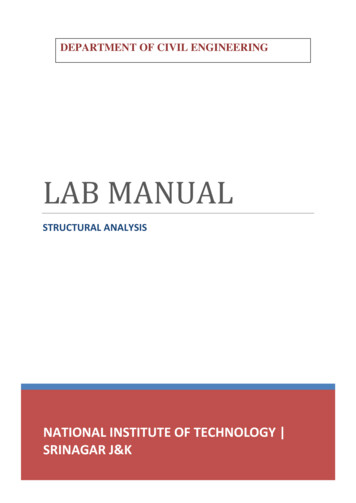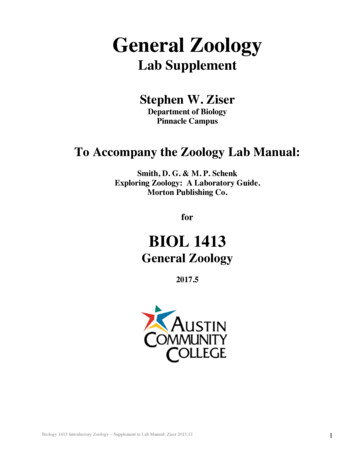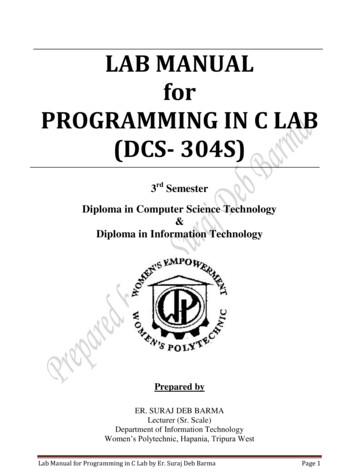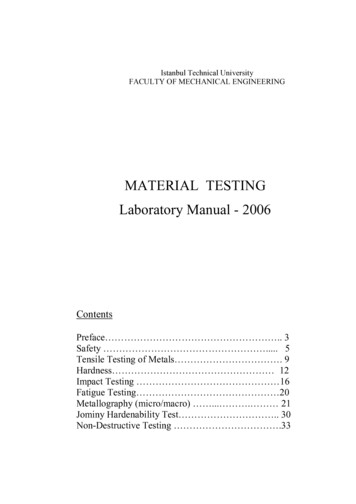
Transcription
DEPARTMENT OF CIVIL ENGINEERINGLAB MANUALSTRUCTURAL ANALYSISNATIONAL INSTITUTE OF TECHNOLOGY SRINAGAR J&K
NATIONAL INSTITUTE OF TECHNOLOGY, SRINAGARVision of the InstituteTo establish a unique identity of a pioneer technical Institute by developing a high-qualitytechnical manpower and technological resources that aim at economic and socialdevelopment of the nation as a whole and the region in particular keeping in view theglobal challenges.Mission of the InstituteM1. To create a strong and transformative technical educational environment in whichfresh ideas, moral principles, research and excellence nurture withinternational standards.M2. To prepare technically educated and broadly talented engineers, future innovatorsand entrepreneurs, graduates with understanding of the needs and problemsof the industry, the society, the state and the nation.M3. To inculcate the highest degree of confidence, professionalism, academicexcellence and engineering ethics in budding engineers.
VISION OF THE DEPARTMENTTo nurture Civil engineers with passion for professional excellence, ready totake global challenges and to serve the society with high human values.MISSION STATEMENT OF THE DEPARTMENT(1) To provide facilities and infrastructure for academic excellence in the field of Civilengineering.(2) To inculcate in the student the passion for understanding professionalism, ethics,safety, sustainability and then actively contribute in the society.(3) To nurture creativity and encourage innovative solutions to real lifechallenging problems in Civil engineering students.(4) To prepare student for lifelong learning in global perspective.PROGRAM EDUCATIONAL OBJECTIVESPEO1: To prepare students to get employment, profession and/or to pursue postgraduation and research in Civil engineering discipline in particular and alliedengineering fields in general.PEO2: To prepare students to identify and analyse Civil engineering problems in aniterative approach that involves defining, quantifying, testing and review of theidentified problem.PEO3: To prepare students to plan, organize, schedule, execute and communicateeffectively as an individual, a team member or a leader in multidisciplinaryenvironment.PEO4: To provide the students, an academic environment that makes them aware ofexcellence in field of Civil Engineering and enables them to understand significance oflifelong learning in global perspective.
INDEX1. To determine Flexural Rigidity (EI) of a given beam2. To verify Maxwell’s Reciprocal theorem.3. To find horizontal thrust in a three-hinged arch and to drawinfluence line diagrams for Horizontal Thrust end Bending moment.4. To find horizontal thrust in a two hinged arch and to drawinfluence linediagrams for horizontal Thrust and bendingmoment.5. To find Critical loan in struts with different end conditions.6. To find deflections in Beam having unsymmetrical bending.7. To find the determination of elastic deflection of curved beams.8. To analysis the redundant joint.
Experiment No. 1Flexural rigidityAim: - To find the value of flexural rigidity (EI) for a given beam and compare it withtheoretical valueApparatus: - Elastic Properties of deflected beam, weight’s, hanger, dial gauge, scale,and Verniar caliper.Formula: - (1) Central upward deflection, y W.a.L2 / 8y . (1)(2) EI W.a. L2 / 8y (2)(3) Also it is known that EI for beam E bd3 /12 (3)Diagram:-Theory: - For the beam with two equal overhangs and subjected to two concentratedloads W each at free ends, maximum deflection y at the centre is given bycentralupward deflection.Central upward deflection, y W.a.L2 / 8EIWhere,a length of overhang on each sideW load applied at the free ends
L main spanE modulus of elasticity of the material of the beamI moment of inertia of cross section of the beamEI W.a.L2 / 8yIt is known that, EI for beam E bd3 /12Where, b width of beamd depth of beamProcedure: i) Find b and d of the beam and calculate the theoretical value of EI by Eq. (3).ii) Measure the main span and overhang span of the beam with a scale.iii) By applying equal loads at the free end of the overhang beam, find the centraldeflection y.iv) Repeat the above steps for different loads.Observation: - 1) Length of main span, L (cm) 2) Length of overhang on each side, a (cm) 3) Width of beam, b (cm) 4) Depth of beam, d (cm) 5) Modulus of elasticity, E (kg/cm2) 2 x106Observation Table:Sr.No. Equalloads at thetwoends (kg)Dial gaugereading atthemidspan ofbeam(cm)EI fromEq. ( 3 )EI fromEq ( 2 ).Calculation: - Average values of EI from observation cm4Average values of EI from calculation .cm4Result: - Flexural rigidity (EI) is found same theoretically and experimentally.Precaution:- 1. Measure the center deflection y very accurately.2. Ensure that the beam is devoid of initial curvature.3. Loading should be within the elastic limit of the materials.
Question:1.2.3.4.5.What is the unit of flexural rigidity?Which types of beam are used in defected beam apparatus?Define the size of beam which is used is used in defected beam apparatus.What is the difference b/w flexural rigidity and flexural stiffness?What is flexural rigidity?
Experiment No.2Maxwell’s reciprocal theoremAim: - To verify clerk Maxwell’s reciprocal theoremApparatus: - Clerk Maxwell’s Reciprocal Theorem apparatus, Weight’s, Hanger, DialGauge, ScaleVerniar caliper.Diagram:-Theory: Maxwell theorem in its simplest form states that deflection of any point A of anyelasticstructure due to load P at any point B is same as the deflection of beam due to sameloadapplied at A. It is, therefore easily derived that the deflection curve for a point in astructure is the sameas the deflected curve of the structure when unit load is appliedat the point for which theinfluence curve was obtained.Procedure: i) Apply a load either at the centre of the simply supported span or at the free end ofthebeam, the deflected form can be obtained.ii) Measure the height of the beam at certain distance by means of a dial gauge beforeandafter loading and determine the deflection before and after at each point separately.iii) Now move a load along the beam at certain distance and for each positions of theload, the deflection of the point was noted where the load was applied in step1.Thisdeflection should be measured at each such point before and after the loading,separately.iv) Plot the graph between deflection as ordinate and position of point on abssica the plotfor graph drawn in step2 and 3.These are the influence line ordinates for deflection ofthebeam.
Observation Table:DistanceLoad at central point/DeflectionLoad moving alongDeflectionfrom thecantilever endof variousbeamof variouspinnedpointspointsend(mm) 2-3(mm) dedloadedDial gaugeDialDial gaugeDial gaugeDial (mm)5(mm)5(mm)6(mm)3Result: - The Maxwell reciprocal theorem is verified experimentally and analytically.Precaution: - (i) Apply the loads without any jerk.(ii) Perform the experiment at a location, which is away from any(iii) Avoid external disturbance.(iv) Ensure that the supports are rigid.Question:1. What is the Maxwell’s reciprocal theorem or define the Maxwell’s reciprocaltheorem?2. What are the purpose of providing dial gauge and magnetic base in theapparatus?3. Maxwell reciprocal theorem in structural analysis can be applied inA. all elastic structuresB. plastic structure C. symmetrical structures onlyD. prismatic element structure only4. What is the difference B/W Maxwell’s reciprocal theorem and betties
Experiment: 3Three hinged arch
Take Moment about the hinge CH 1-[v2f:. w (a -!:.)]h'281Procedure:1.Use lubricating oil at the roller end of the arch so as to have a free movement of the rollerend.ii. Balance the sci f-weight of the arch by placing load on hanger for horizontal thrust until theequilibrium conditions is obtained. Under this condition, the roller end of the arch has atendency to move inside on tapping the table. Note down the load in kg.iii. Place a few loads on the arch in any chosen positions. Balance these by placing additionalweights on the hanger for horizontal thrust. The additional weights on the thrust hanger givethe experimental value of the horizontal thrust.Observation:Span of the arch,L Central rise,h Initial load on the thrust hanger for balancing,Load Applieds.on Hanger kgNo.I2w,w,w,w,w,rv,w,Distance fromLeft handSupportcm Additional loadon thrust hangerCalculated 11.Put the weights in thrust hanger very gently without a jerk.Measure the distance of loaded points from left hand support accurately. Perform theexperiment away from vibration and other disturbances.Results:1.Find the horizontal thrust for a given set of load experimentally and theoretically.Experimental value of horizontal thrust, fl.,, Theoretical value of horizontal thrust, H,. Commrnts:
Question:Define two hinge arches?What is the main difference in three hinged arch and two hinge arch?Three hinge arch structure are- (a) Determinate structure (b) IndeterminateStructure.The bending moment of three hinge arch is greater than the bending moment ofbeam. (a) True (b) False.Write the expression for bending moment at any section on the arch. Given- VA Vertical load at point A , W1 load from end A at distance a, H horizontal force atpoint A , x e/s distance from AON the basis of support conditions arches are classified / classified the arches onthe basis support conditions.
Experiment No. 4Two hinged archAim: - To study two hinged arch for the horizontal displacement of the roller end for agiven system of loading and to compare the same with those obtained analytically.Apparatus: - Two Hinged Arch Apparatus, Weight’s, Hanger, Dial Gauge, Scale, VerniarCaliper.Formula: - H 5WL (a – 2a³ a4)/8rWhere,W Weight applied at end support.L Span of two hinged arch.r rise of two hinged arch.a dial gauge reading.Diagram:-Theory: - The two hinged arch is a statically indeterminate structure of the firstdegree.The horizontal thrust is the redundant reaction and is obtained y the use ofstrain energy methods. Two hinged arch is made determinate by treating it as a simplysupported curved beam and horizontal thrust as a redundant reaction. The arch spreads
out under external load. Horizontal thrust is the redundant reaction is obtained by theuse of strain energy method.Procedure: i) Fix the dial gauge to measure the movement of the roller end of the model and keep thelever out of contact.ii) Place a load of 0.5kg on the central hanger of the arch to remove any slackness andtaking this as the initial position, set the reading on the dial gauge to zero.iii) Now add 1 kg weights to the hanger and tabulated the horizontal movement of theroller end with increase in the load in steps of 1 kg. Take the reading up to 5 kg load.Dial gauge reading should be noted at the time of unloading also.iv) Plot a graph between the load and displacement (Theoretical and Experimental)compare. Theoretical values should be computed by using horizontal displacementformula.v) Now move the lever in contact with 200gm hanger on ratio 4/1 position with a 1kgload on the first hanger. Set the initial reading of the dial gauge to zero.vi) Place additional 5 kg load on the first hanger without shock and observe the dial gaugereading.vii) Restore the dial gauge reading to zero by adding loads to the lever hanger, say theload is w kg.viii) The experimental values of the influence line ordinate at the first hanger positionshall be 4w.ix) Repeat the steps 5 to 8 for all other hanger loading positions and tabulate. Plot theinfluence line ordinates.x) Compare the experimental values with those obtained theoretically by using equation(5).
Observation Table: -Sr.Central loadNo.(kg)Horizontal lDisplacement( mm )CalculatedhorizontalDisplacementEq. (4)Sample Calculation: - Central load (kg) .Observed horizontal Displacement (mm) Calculated horizontal Displacement H 5WL (a – 2a³ a4)/8r .Result:-The observed and horizontal displacement is nearly same.Precaution: - 1.Apply the loads without jerk.2. Perform the experiment away from vibration and otherdisturbances.Question:1. Define two hinged arch.2. Two hinged arch structure area. Determinate structure b. indeterminate structure3. What is the application of two hinged arch?4. Two hinged arch construction are complicated – TRUE/FLASE5. The load carrying capacity of two hinge arch is higher than beams- TRUE/FLASE6. The bending moment of arch is higher than the B.M. of beam- TRUE/FLASE
Experiment No 5Column and bucklingObject: - To study behavior of different types of columns and find Euler’s buckling load foreach case.Apparatus: - Column Buckling Apparatus, Weights, Hanger, Dial Gauge, Scale, Verniarcaliper.Diagram:-Theory: -If compressive load is applied on a column, the member may fail either by crushingor by buckling depending on its material, cross section and length. If member is considerablylong in comparison to its lateral dimensions it will failby buckling. If a member showssignsof buckling the member leads to failurewith small increase in load. The load at whichthe member just buckles is called as crushing load. The buckling load, as given by Euler, canbe found byusing following expression.
P π² EI/le²Where,E Modulus of Elasticity 2 x 105 N/mm2 for steelI Least moment of inertia of column sectionLe Effective length of columnDepending on support conditions, four cases may arise. The effective length for each ofwhichare given as:1. Both ends are fixed le L/ 22. One end is fixed and other is pinned le L/ 23. Both ends are pinned le L4. One end is fixed and other is free le 2LProcedure: i) Pin a graph paper on the wooden board behind the column.ii) Apply the load at the top of columns increasing gradually. At certain stage of loading thecolumns shows abnormal deflections and gives the buckling load.iii) Not the buckling load for each of the four columns.iv) Trace the deflected shapes of the columns over the paper. Mark the points of changeof curvature of the curves and measure the effective or equivalent length for each case separately.v) Calculate the theoretical effective lengths and thus buckling loads by the expressionsgiven above and compare them with the observed values.Observation: 1) Width of strip (mm) b 2) Thickness of strip (mm) t 3) Length of strip (mm) L 4) Least moment of inertiaI bt³/12Observation Table:Sr.NoEnd conditionEuler’sBuckling load (P π² EI)Theoretical1.Both ends fixedObservedEffective Length (mm)TheoreticalObserved
2.3.4.One end fixedand other pinnedBoth ends pinnedOne end fixedand other free.Sample Calculation: - Both ends fixedEuler’s buckling load. le²Effective Length (mm) .Result:-The theoretical and experimental Euler’s buckling load for each case is foundnearlysame.Question:1.2.3.4.Define buckling?What is the difference b/w buckling and twisting?What is the difference b/w column and strut?Define buckling facture?
Experiment No-6Deflections of beamAim: - To verify the moment area theorem regarding the slopes and deflections of the beam.Apparatus: - Moment of area theorem apparatus.Diagram:-Fig.Theory : - According to moment area theorem1. The change of slope of the tangents of the elastic curve between any two points ofthedeflected beam is equal to the area of M/EI diagram between these two points.2. The deflection of any point relative to tangent at any other point is equal to themoment ofthe area of the M/EI diagram between the two points at which thedeflection is required.Slopeat B Y2 / bsince the tangent at C is horizontal due to symmetry,Slope at B shaded area / EI 1 / EI [Wa2 / 2 WA (L/2 – a)]Displacement at B with respect to tangent at C (y1 y2) Moment of shaded area about B / EI 1 / EI [Wa2 / 2 (b 2/3a) Wa(L/2 –a) (b a/2 L/2)]Procedure: 1. Measure a, b and L of the beam2. Place the hangers at equal distance from the supports A and load them with equal loads.3. Measure the deflection by dial gauges at the end B (y2) and at the center C (y1)4. Repeat the above steps for different loads.
Observation Table:Length of main span, L (cm) Length of overhang on each side, a (cm) Modulus of elasticity, E (kg/cm2) 2 x 106Sl. No.Load at eachCentralDeflection atSlope at BHanger (kg)DeflectionFree end y2Y2 / bY1 (cm)(cm)Deflection atC Deflection atB (y1)Calculation:1. Calculate the slope at B as y2 / b (measured value).2. Compute slope and deflection at B theoretically from B.M.D. and comparewithexperimental values.3. Deflection at C y1(measured value).4. Deflection at C Average calculated valueResult: -The slope and deflection obtained is close to the slope and deflection obtained byusing moment area method.Precaution:1. Apply the concentration loads without jerks.2. Measures the deflection only when the beam attains ion.3. Measures the deflection very carefully and accurately.4.Check the accuracy and least count of dial gauges used for measuring deflections.
Experiment:-7Deflection of curved members
- Moment of Inertia ofthe cross section of the curved memberbd!12 -I lorizental displacement at point O ( 5118)6,,. PK2EIb. Quadrant of a circle with a straigh: leg.The member is a quadrant from point A to Band then straight line from B to CVertical displacement at point C along the line of action of the load ( 6,.-.)areJ Jorizontalc nPR'yElo'displacemem at point B ( 0118)Ty26,c -- PR [ ;ry n-R-' 4yR ]2EI8. B1Ac. Semksrcte with straig/11 armVertical displacement at point C along the line of action of the load (o,,,.)-y---tp2]6It",,,,, PR[ nR' .!L;r:.:.L. JE/El:e2RHorizontal displacement at point B ( 0118)6IIC.c -PR'[ nR l. ] /2d. CircleVertical displacement at point C along the line of action of the load ( o,-.)a. --nPR'21E/AProcedure:,.Place a load of 0.5 kg on the hanger to activate the member and treat this as the initialposition for measuring deflection.11.111.FLx the dial gauges for measuring horizontal and vertical deflections.Place the additional loads at an increment of 0.5 kg and tabulate the dial gauge readingsagainst the applied loads.
Calculation:
Experiment:- 8Analysis of Redundant frameAim:
4. Apply load at increments and note down the horizontal and vertical displacements and thereading in each spring.5. Calculate the tension force in each spring, horizontal and vertical displacement of point Dand compare with the experimental results.Observation: Length of member ADLength of member BOLength of member CDDistance aDistance bYoung's Modulus, EDeflection in member, mmLoad, kgADBOCD1.02.03.04.0load, kgHorizontal, UVertical, VDeflection, mmSurina ADSoring BOSpring culate the spring stiffnesses carefully.Measure the distances AD, BD, CD, a and b accurately.Tap the dial gauges before taking a reading for vertical and horizontal n, mmu1.02.03.04.0Comments:vAnalyticalForce, NT,T2TiDeflection,mmuForce, NvT,T2Ti
STRUCTURAL ANALYSIS DEPARTMENT OF CIVIL ENGINEERING . NATIONAL INSTITUTE OF TECHNOLOGY, SRINAGAR Vision of the Institute To establish a unique identity of a pioneer technical Institute by developing a high-quality technical manpower and technological resources that aim at economic and social .











